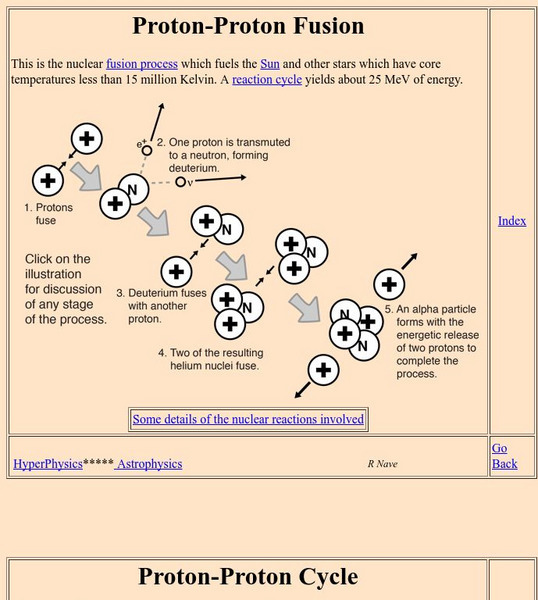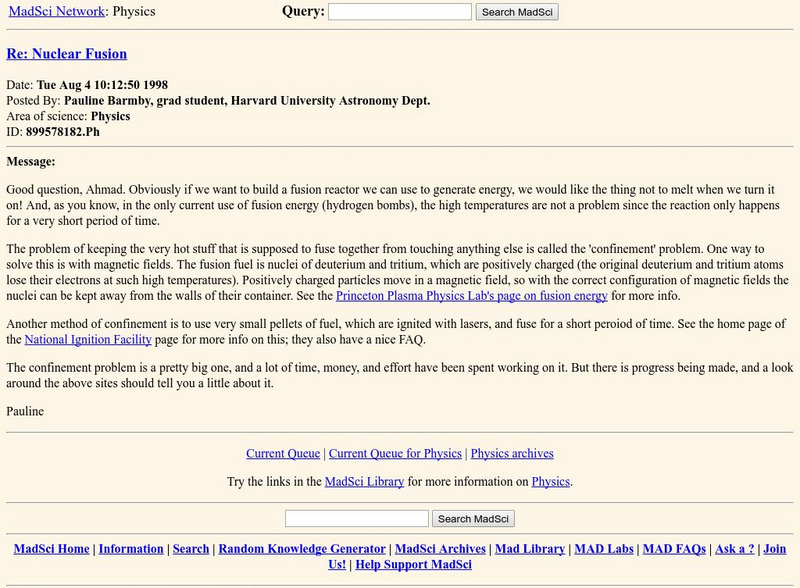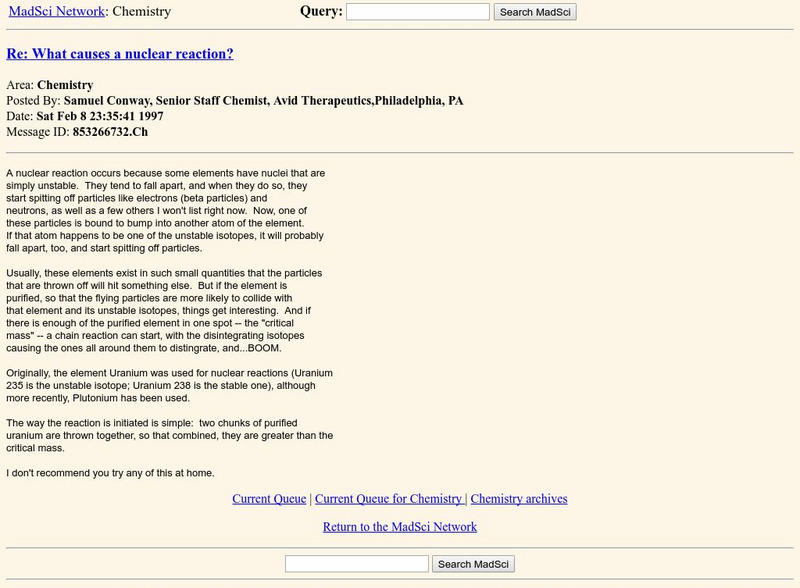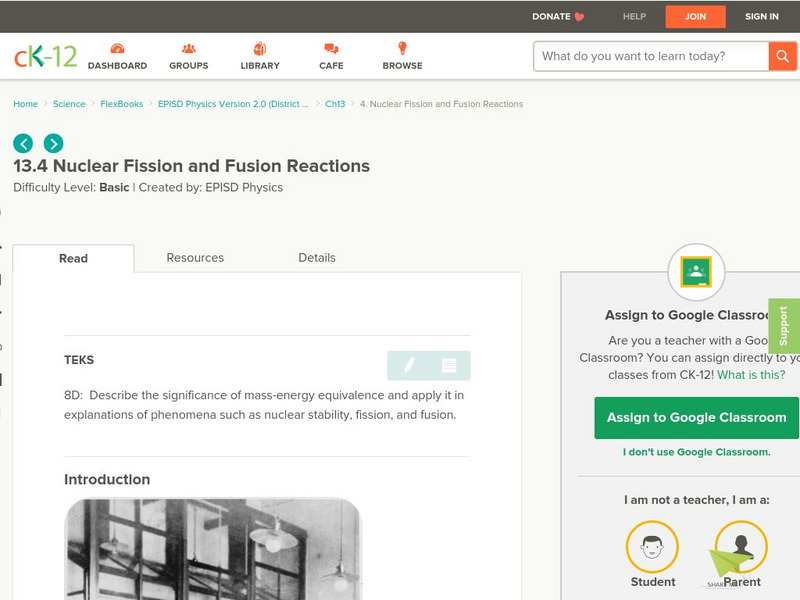CK-12 Foundation
Ck 12: Physical Science: Nuclear Fusion
[Free Registration/Login may be required to access all resource tools.] What nuclear fusion is and how and where it occurs. Using nuclear fusion to produce energy and its pros and cons.
Mocomi & Anibrain Digital Technologies
Mocomi: Nuclear Fission and Nuclear Fusion
Nuclear fission and nuclear fusion are reactions that convert matter into energy. Learn the difference.
National Academies of Sciences, Engineering, and Medicine
The National Academies: Our Energy Sources: Nuclear Energy
Nuclear fission energy accounts for a large portion of energy production worldwide. New plants will use improved technologies. There is also research underway to explore how to harness the energy produced from nuclear fusion, but this...
PBS
Pbs Learning Media: Nuclear Blast Damage
This illustrated document from the AMERICAN EXPERIENCE Web site examines the "zones of destruction" caused by nuclear weapons.
Other
Princeton Plasma Physics Laboratory: Fusion Basics
A wealth of background information on nuclear fusion and its potential use as a commercial energy resource. The advantages of nuclear fusion over other resources, the conditions required for its successful implementation and the future...
Other
Lcid: Comparison of Fission and Fusion Processes
From the Science Teacher's Resource Center. A data sheet tabulating the many differences between nuclear fission and nuclear fusion. Technical information about the nuclear reactions, the mass defect, isotope masses, etc. is included.
Energy for Sustainable Development
Esd Bulgaria: Kids & Energy: Uranium (Nuclear)
Nuclear energy is energy in the nucleus of an atom. Atoms are tiny particles that make up every object in the universe. There is enormous energy in the bonds that hold atoms together. Nuclear energy can be used to make electricity. But...
Georgia State University
Georgia State University: Hyper Physics: Proton Proton Fusion
A look at the reaction that fuels the Sun with this diagram of the nuclear fusion process.
MadSci Network
The Mad Scientist Network: About Nuclear Fusion
Using a question and answer format, this page introduces and explains the idea of nuclear fusion. The hydrogen bomb and its operation is discussed. Other applications of nuclear fusion are described. Short but clear.
MadSci Network
The Mad Scientist Network: About Nuclear Fusion
Using a question and answer format, this page introduces and explains the idea of nuclear fusion. The hydrogen bomb and its operation is discussed. Other applications of nuclear fusion are described. Short but clear.
Chiral Publishing
Chiral Publishing: An Introduction to Chemistry: Nuclear Energy: Audio Book
Listen and learn as you view examples and explanations of nuclear energy. View examples and formulas for binding energy, nuclear fission, chain reaction, and nuclear power.
Texas Education Agency
Texas Gateway: Fusion and Fission
Given diagrams, illustrations, symbols, or descriptions, student will distinguish between nuclear fusion and nuclear fission.
Georgia State University
Georgia State University: Hyper Physics: Nuclear Fusion
This site from Georgia State University provides a lengthy page with a thorough description of the fusion process. Discussion is complemented by excellent graphics and links to further information.
Lawrence Berkeley National Laboratory
Berkeley Lab: Nuclear Fusion Power
Provides a brief explanation of nuclear fusion power which offers the promise of an almost inexhaustible source of energy for future generations if the reactors can be made to work.
US Department of Energy
Fus Ed Web: Physics of a Fundamental Energy Source
An excellent resource on nuclear fusion! Using incredible graphics and excellent discussion, this site (with its several pages) provides an exhaustive online course on the topic. Click on the link for "a Guided Tour" and begin.
Other
Nuclear Threat Initiative: Nuclear 101: Nuclear Weapons
Interactive tutorial helps with understanding nuclear weapons, the different types, how they are different from conventional weapons, and how many countries have developed them.
MadSci Network
Msn: What Happens in a Nuclear Reaction?
From The Mad Scientist Network web site. Using a question and answer format, this page discusses three types of nuclear reactions - spontaneous decay reactions, nuclear fision reactions, and nuclear fusion reactions. Each reaction type...
CK-12 Foundation
Ck 12: Nuclear Fission and Fusion Reactions
[Free Registration/Login may be required to access all resource tools.] This lesson explains the processes of nuclear fission and nuclear fusion. Includes simulations on nuclear fission and on isotope decay.
Atomic Archive
Nuclear Fusion: The Hydrogen Bomb
From the Atomic Archive - the online companion to the award-winning CD-ROM. This page (and the couple that follow from it) describe the use of fusion reactions in a hydrogen bomb. A schematic diagram of an H-bomb is given and discussed....
CK-12 Foundation
Ck 12: Fission and Fusion
[Free Registration/Login may be required to access all resource tools.] Students will investigate fission and fusion, and discover how they play a part in nuclear chain reactions in fission bombs, nuclear power plants, and radiation in...
Other
Need: Exploring Nuclear Energy [Pdf]
This downloadable article addresses all aspects of nuclear energy. Visual charts make understanding of cycles and concepts easier. Most useful for older students and educators. PDF (requires Adobe Reader).
Georgia Department of Education
Ga Virtual Learning: Nuclear Physics
Through informational text, interactive activities, and virtual animations students learn about the atomic nucleus, fission, fusion, and radioactive decay.
Chiral Publishing
Chiral Publishing: An Introduction to Chemistry: Nuclear Chemistry: Audio Book
Learn about nuclear energy as you listen to the audio book describing nuclear chemistry. View maps, examples, graphs, and pictures describing everything from electrons to beta emissions and more.
NASA
Nasa: The Sun's Energy Source
This site, which is provided by NASA, gives some scientific history and a clear and detailed explanation of nulcear forces and nuclear fusion.
Other popular searches
- Sun Nuclear Fusion
- Nuclear Fusion and Fission
- Stars Nuclear Fusion
- Nuclear Fusion in Stars
- Nuclear Fusion Lab
- Earth Science Nuclear Fusion
- Nuclear Fusion Within Star
- Physics of Nuclear Fusion
- Nuclear Fusion and Fision




















